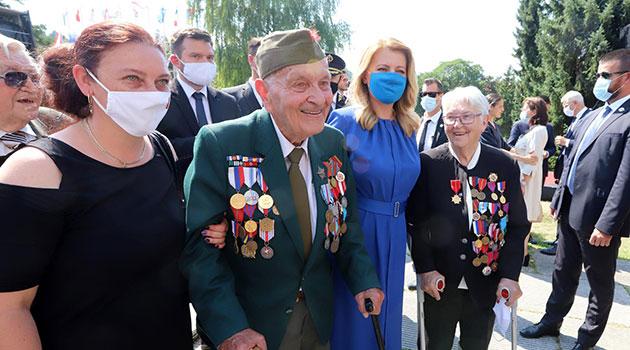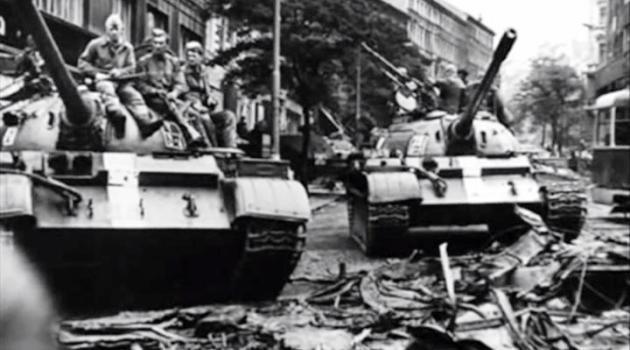Slovak President commemorates WWII-era National Uprising to which Roma also contributed

A civilization’s values must be defended before the first signs of their being under threat ever appear. Slovak President Zuzana Čaputová expressed that sentiment in a speech celebrating the anniversary of the Slovak National Uprising, the armed revolt against fascism by Slovaks during the Second World War.
Historians have published research confirming that Romani people were also involved in the Slovak National Uprising. “In August 1944, you knew you were living at a time when a human life seemed to have lost its worth. All resistance to the regime at that time was punished with death or prison. Despite the risk, you found the strength and determination in yourselves and joined the armed struggle against fascism and Nazism,” the President told those attending the commemoration.
The uprising broke out in August 1944 and was joined by fighters from many countries, including the then-Protectorate of Bohemia and Moravia, some of whom were Romani – and was eventually suppressed. The uprising helped Slovakia, which was working with Nazi Germany during the war, to ultimately join the ranks of the victorious anti-Nazi coalition.
By rising up in Slovakia, the basis was established for the postwar renewal of a common state for Czechs and Slovaks. Today Slovakia commemorates the anniversary of the beginning of the Slovak National Uprising as a state holiday.
“It’s up to each one of us which side we take on the arguments of our day and whether we take a stand for the values that will aid Slovakia in becoming a free, independent, democratic, humane and prosperous country,” the President said during the ceremony in Banská Bystrica, central Slovakia, which was the center of the uprising. The speaker of the unicameral legislature, Boris Kollár, and Slovak Prime Minister Igor Matovič also expressed their appreciation for the importance of the Slovak National Uprising.
Kollár said the uprising is one of the most important milestones in Slovakia’s modern history. He also said the return of neo-fascism and neo-Nazism are a danger today.
Matovič said those who participated in the Slovak National Uprising gave courage to all of Slovakia. “The Slovak National Uprising was an uprising against people who said we are not all equal,” he reminded those assembled.
The Prime Minister added that the rebellion had not just been a rising up against “bad” people from abroad, but also against their collaborators in Slovakia. Of the parties seated in the legislature, representatives of the ultra-right “Kotleba-People’s Party Our Slovakia”, which is chaired by Marian Kotleba, have repeatedly objected in the past to the Slovak National Uprising, because that formation espouses legacy of the wartime Slovak State.
Roma during the Slovak National Uprising
As news server Romea.cz and other media have reported, Romani people were also involved in the Slovak National Uprising – ethnologist and historian Zuzana Kumanová has reminded the public of Anton Facuna, for example, who actively fought in the uprising in the spring of 1944. In Rome, Facuna contacted the Czechoslovak Government-in-exile’s military mission and, as an interpreter, arrived on rebel territory with an American airborne unit.
Facuna was trained by a specialist from America’s Office of Strategic Services, the predecessor to the CIA, in special operations. “He was assigned to the Day group as a guide and helped under the cover name Anton Novák,” Kumanová said.
Together with five American colleagues, Facuna was dropped off at Tri Duby Airport by an American B-17, the “Flying Fortress”. The group headed to Bratislava, where Facuna taught Slovak officers how to handle American arms.
During the uprising, legends circulated about Facuna and his “Hussar pieces”. The Germans even put a bounty on him.
“After the war, Facuna was given a Czechoslovak medal for participating in the Slovak National Uprising and was recognized by the American government,” the historian said. Facuna became the first chair of the Union of Gypsies-Roma (Zväz Cigánov-Romov) in Slovakia and worked on a Romanes-Slovak dictionary.
The Romani fighter did not manage to complete the dictionary before passing away in 1980. Kumanová has also reminded the public that oral histories from previous decades even mention an independent partisan group in Slovakia that was said to have been led by a Romani man, the partisan Oračko.
The historian estimates that approximately 1 400 Romani people lost their lives during the uprising. She also said that after the uprising broke out, the Germans intensified their repression against the Romani popuation of Slovakia.
“The reason was not just the active involvement of Romani people among the partisans, but also accusations that they aided and collaborated with the resistance,” she said. Since August 2017 a memorial plaque at the Museum of the Slovak National Uprising in Banská Bystrica has commemorated the active participation of Romani people during those events.
